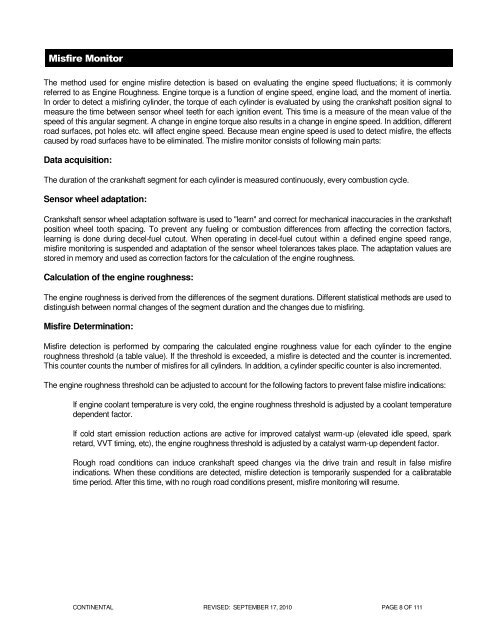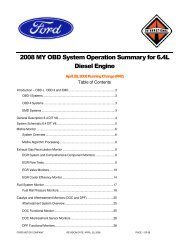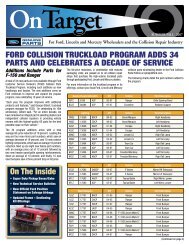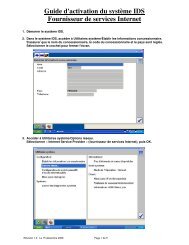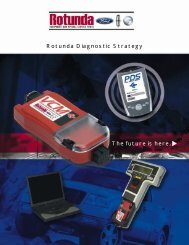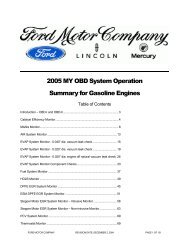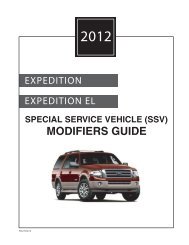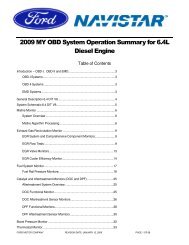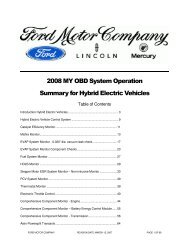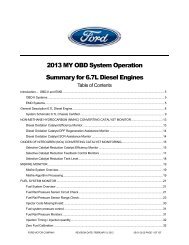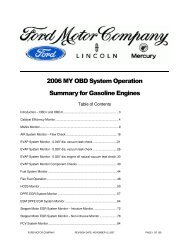OBD Operation Summary for Fiesta - MotorCraftService.com
OBD Operation Summary for Fiesta - MotorCraftService.com
OBD Operation Summary for Fiesta - MotorCraftService.com
- No tags were found...
You also want an ePaper? Increase the reach of your titles
YUMPU automatically turns print PDFs into web optimized ePapers that Google loves.
Misfire MonitorThe method used <strong>for</strong> engine misfire detection is based on evaluating the engine speed fluctuations; it is <strong>com</strong>monlyreferred to as Engine Roughness. Engine torque is a function of engine speed, engine load, and the moment of inertia.In order to detect a misfiring cylinder, the torque of each cylinder is evaluated by using the crankshaft position signal tomeasure the time between sensor wheel teeth <strong>for</strong> each ignition event. This time is a measure of the mean value of thespeed of this angular segment. A change in engine torque also results in a change in engine speed. In addition, differentroad surfaces, pot holes etc. will affect engine speed. Because mean engine speed is used to detect misfire, the effectscaused by road surfaces have to be eliminated. The misfire monitor consists of following main parts:Data acquisition:The duration of the crankshaft segment <strong>for</strong> each cylinder is measured continuously, every <strong>com</strong>bustion cycle.Sensor wheel adaptation:Crankshaft sensor wheel adaptation software is used to "learn" and correct <strong>for</strong> mechanical inaccuracies in the crankshaftposition wheel tooth spacing. To prevent any fueling or <strong>com</strong>bustion differences from affecting the correction factors,learning is done during decel-fuel cutout. When operating in decel-fuel cutout within a defined engine speed range,misfire monitoring is suspended and adaptation of the sensor wheel tolerances takes place. The adaptation values arestored in memory and used as correction factors <strong>for</strong> the calculation of the engine roughness.Calculation of the engine roughness:The engine roughness is derived from the differences of the segment durations. Different statistical methods are used todistinguish between normal changes of the segment duration and the changes due to misfiring.Misfire Determination:Misfire detection is per<strong>for</strong>med by <strong>com</strong>paring the calculated engine roughness value <strong>for</strong> each cylinder to the engineroughness threshold (a table value). If the threshold is exceeded, a misfire is detected and the counter is incremented.This counter counts the number of misfires <strong>for</strong> all cylinders. In addition, a cylinder specific counter is also incremented.The engine roughness threshold can be adjusted to account <strong>for</strong> the following factors to prevent false misfire indications:If engine coolant temperature is very cold, the engine roughness threshold is adjusted by a coolant temperaturedependent factor.If cold start emission reduction actions are active <strong>for</strong> improved catalyst warm-up (elevated idle speed, sparkretard, VVT timing, etc), the engine roughness threshold is adjusted by a catalyst warm-up dependent factor.Rough road conditions can induce crankshaft speed changes via the drive train and result in false misfireindications. When these conditions are detected, misfire detection is temporarily suspended <strong>for</strong> a calibratabletime period. After this time, with no rough road conditions present, misfire monitoring will resume.CONTINENTAL REVISED: SEPTEMBER 17, 2010 PAGE 8 OF 111


